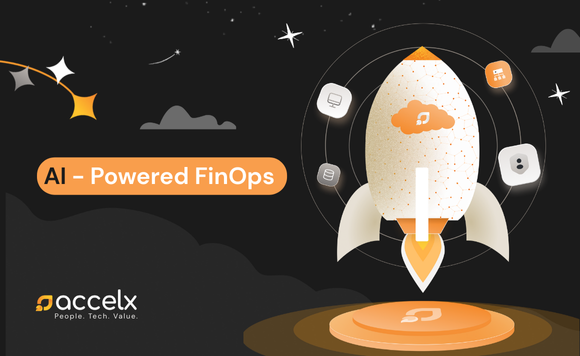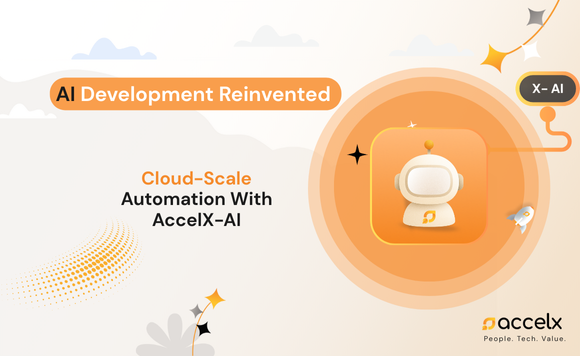How Can AI-Powered FinOps Transform Your Multi-Cloud Cost Management Strategy?
AI-powered FinOps is redefining multi-cloud cost management in 2025. With cloud spend surpassing $100B and nearly half wasted, organizations need automation, predictive analytics, and intelligent agents. This guide explores why traditional FinOps fails and how AI-driven strategies unlock efficiency, savings, and scalability.

Cloud cost management has reached a critical inflection point in 2025. With organizations spending over $100 billion annually on cloud services, and MIT research indicating that half of this spending is wasted, the need for intelligent automation has never been greater. This comprehensive guide reveals how AI-driven FinOps agents solve the fundamental challenges of multi-cloud cost optimization, delivering measurable business outcomes through autonomous financial operations.
Why Traditional Cloud Cost Management Fails Organizations?
The Scale of the Problem
According to MIT startup research, over $100 billion is spent annually on cloud services, with approximately 50% of that investment being wasted due to inefficient resource allocation and manual optimization approaches. This represents one of the largest opportunities for cost optimization in modern business.
Key Challenges Organizations Face
Manual Processes Cannot Match Cloud Scale
Research from Technion's Cloud Resource Management lab demonstrates that traditional manual approaches to resource optimization cannot keep pace with modern cloud environments. Their simulation studies over real production data center traces show that manual resource management leads to significant underutilization.
Multi-Cloud Complexity Overwhelms Teams
IDC's 2025 FinOps Cloud Transparency research identifies six key market segments struggling with cost management: infrastructure-as-a-service optimization, reporting and pricing analytics, software-as-a-service management, FinOps service providers, container optimization, and GreenOps.
Resource Constraints Limit Effectiveness
Harvard Business Review's analysis reveals that many enterprises "struggle to properly manage cloud costs" despite moving to the cloud to accelerate innovation and growth. The promise of cost savings often becomes a reality of cost overruns without proper FinOps frameworks.
What Makes Multi-Cloud Cost Control So Difficult?
Exponential Complexity in Resource Options
MIT's analysis of cloud optimization challenges highlights the scale of complexity: "Amazon Web Services alone offers an evolving menu of 400 different machines with hundreds of settings and fluctuating prices". When combined with various processing frameworks, this creates "trillions of combinations" for deployment options.
Traditional IT Management Tactics Don't Apply
According to Harvard Business Review research, "The traditional tactics of managing spending for on-premises IT do not apply to cloud spend". The shift from capacity-focused forecasting to scalable, immediate needs creates fundamental challenges in financial management.
The Growth of FinOps Market Demand
Flexera's 2025 market analysis shows the global cloud FinOps market expanding from $14.93 billion in 2025 to approximately $38.33 billion by 2034, with a projected CAGR of 11%. This growth is "driven by the increasing need for cost transparency and financial accountability in cloud environments."
The Solution: AI-Powered FinOps Agents for Autonomous Optimization
How AI Addresses Core FinOps Challenges?
Autonomous Real-Time Decision Making
Red Hat's research on multicloud cost optimization demonstrates how AI-powered tools can handle the complexity that human teams cannot. Their Cloud Cost Optimizer (CCO) research shows that "cost optimization requires continuous monitoring and analysis of usage data" - a task perfectly suited for AI automation.
Unified Multi-Cloud Intelligence
Building on AccelX's proven expertise in AI automation, demonstrated through AccelX-AI's genetic algorithm approach to model optimization, our FinOps platform applies similar evolutionary algorithms to cost optimization across AWS, Azure, and GCP environments.
Predictive Resource Allocation
Technion research shows that AI-driven resource management can reduce overall recovery costs by 10-15% compared to traditional approaches. Their fault-recovery cost aware placement algorithms demonstrate how predictive analytics improve resource utilization efficiency.
The Evolution of FinOps Practice
According to the FinOps Foundation definition cited by MIT ESP research: "FinOps is an evolving cloud financial management discipline and cultural practice that fosters collaboration among engineering, finance, technology, and business teams to make data-driven spending decisions".
Before and After: The AI FinOps Transformation
Before: Manual FinOps Struggles
Enterprise Scenario:
- Teams struggle with visibility across cloud accounts
- Cost allocation requires weeks of manual analysis
- Optimization opportunities missed due to complexity
- Reactive rather than predictive management
Startup Scenario:
- Founders spend significant time on cost management
- Budget overruns discovered after they occur
- Scaling decisions delayed by cost uncertainty
After: AI Agent Automation
Enterprise Excellence:
- Automated governance across hundreds of accounts
- Real-time cost allocation with audit trails
- Predictive optimization before issues arise
- Strategic focus replaces tactical firefighting
Startup Transformation:
- AI handles majority of cost optimization automatically
- Real-time alerts prevent budget overruns
- Confident scaling decisions based on predictive analytics
- Unified dashboard provides instant multi-cloud visibility
Common FinOps Implementation Mistakes
Mistake 1: Focusing Only on Cost Reduction
Harvard Business Review research emphasizes that successful FinOps requires "balancing cloud costs and business goals". Organizations often optimize purely for cost without considering business value creation, leading to performance degradation.
Mistake 2: Treating FinOps as Pure Technology
MIT ESP research highlights that FinOps is fundamentally "a cultural practice" requiring collaboration across teams. Technology deployment without organizational alignment leads to adoption failures.
AI-Powered vs Traditional FinOps Comparison
%20(567%20x%20550%20px).png)
Business Outcomes from AI-Driven FinOps
Quantified Results from Research
MIT Cost Optimization Research
MIT spinout Sync Computing demonstrates that proper cloud optimization can recover up to 50% of wasted cloud spending. Their research shows that determining optimal infrastructure settings manually "is neither practical nor physically possible" at cloud scale.
Academic Performance Improvements
Technion research validates 10-15% cost reduction through intelligent resource management. Their simulation studies over real production traces demonstrate consistent performance improvements through automated optimization.
Market Growth Validation
IDC's 2025 MarketScape research notes that hyperscalers have "significantly enhanced the capabilities of their FinOps tools" with enterprises increasingly leveraging FinOps processes to "maximize their cloud investment".
Strategic Business Benefits
Like AccelX-AI's approach to automating complex model optimization, AI-powered FinOps delivers:
- Immediate cost impact within 90 days
- Operational efficiency through automated processes
- Strategic focus enabling innovation over administration
- Scalable governance across growing cloud environments
Implementation: Deploying AI-Powered FinOps Successfully
Phase 1: Assessment and Discovery (Week 1-2)
Following MIT ESP's FinOps framework, begin with the "Inform" stage:
- Automated cataloging of cloud resources across providers
- Baseline cost analysis and immediate optimization identification
- Business objective alignment and success metrics definition
Phase 2: Intelligent Configuration (Week 3-4)
Implement the "Optimize" stage with AI enhancement:
- Machine learning analysis of organizational usage patterns
- Automated policy recommendation based on best practices
- Integration with existing cloud management workflows
Phase 3: Autonomous Operation (Week 5+)
Deploy the "Operate" stage with continuous AI optimization:
- Real-time cost optimization across multi-cloud environments
- Predictive analytics for scaling and capacity planning
- Automated reporting and compliance documentation
What Makes AccelX's AI FinOps Different?
Proven AI Automation Expertise
AccelX's FinOps platform builds on our demonstrated success with AccelX-AI's evolutionary algorithms, where customers achieve 80% faster development cycles and 50% cost reductions. The same AI principles that optimize model performance now optimize cloud financial performance.
Comprehensive Multi-Cloud Intelligence
Following IDC's FinOps market framework, our platform addresses all six key optimization areas:
- Infrastructure-as-a-service optimization
- Advanced reporting and pricing analytics
- Software-as-a-service cost management
- Container environment optimization
- Sustainability (GreenOps) metrics
- Service provider cost analysis
Research-Backed Methodology
Our approach incorporates findings from leading academic research:
- MIT's cloud optimization principles
- Technion's resource management algorithms
- Harvard Business Review's FinOps frameworks
Frequently Asked Questions About AI-Powered FinOps
How do AI agents ensure accuracy and reliability?
AI agents operate using research-validated algorithms, similar to those studied at Technion for cloud resource management. The platform includes built-in safeguards, approval workflows for significant changes, and detailed audit logging for compliance purposes.
What's the typical ROI timeline for implementation?
Based on MIT research showing 50% waste recovery potential and Technion's validated 10-15% optimization improvements, most organizations see significant cost reduction within 90 days, with the platform typically paying for itself through automated savings.
Can AI FinOps integrate with existing tools?
Yes. Following IDC's market analysis of FinOps tools, our platform integrates with cloud-native tools, point solutions, and comprehensive management suites across AWS, Azure, and GCP environments.
How does the platform handle multi-cloud complexity?
Our AI agents address the complexity identified in MIT research - handling "trillions of combinations" of deployment options through automated optimization that human teams cannot practically manage.
What happens if optimization decisions need adjustment?
All AI decisions include rollback capabilities and approval processes for significant changes, following the collaborative principles outlined in FinOps Foundation guidelines.
Summary: Transform Cloud Financial Management with AI
AI-powered FinOps represents the natural evolution of cloud cost management, addressing the fundamental challenges identified by leading research institutions. With proven cost recovery potential of up to 50% and automation capabilities that handle complexity beyond human scale, AI agents provide the solution organizations need.
Whether you're scaling a startup or managing enterprise cloud environments, AI-driven FinOps delivers the cost optimization and governance capabilities necessary for success. Building on AccelX's proven AI automation expertise, demonstrated through our AccelX-AI platform, intelligent agents transform cloud financial operations from reactive cost management to predictive business optimization.
Ready to recover the wasted 50% of your cloud spending? AI-powered FinOps makes autonomous cost optimization a reality today.


